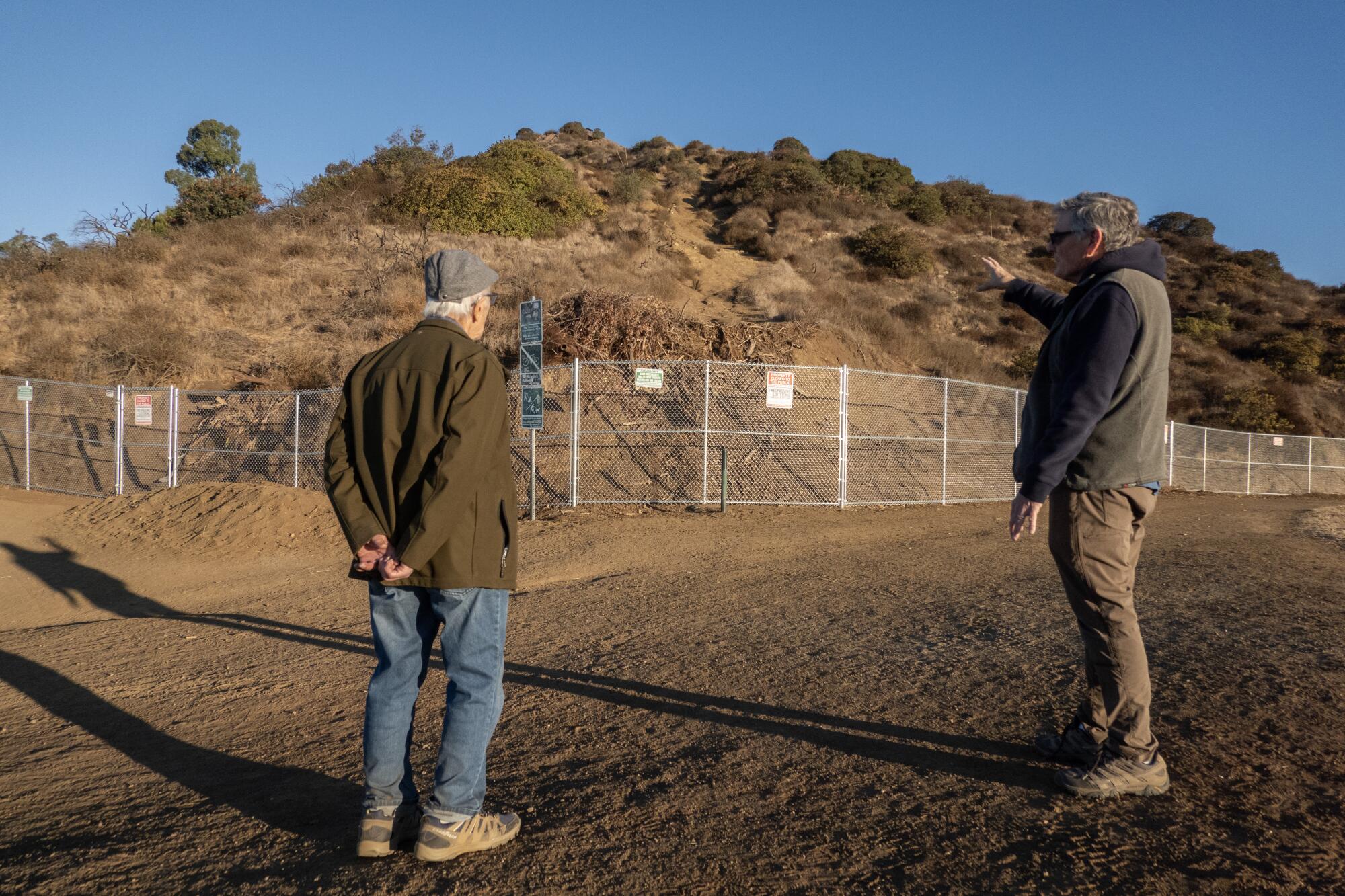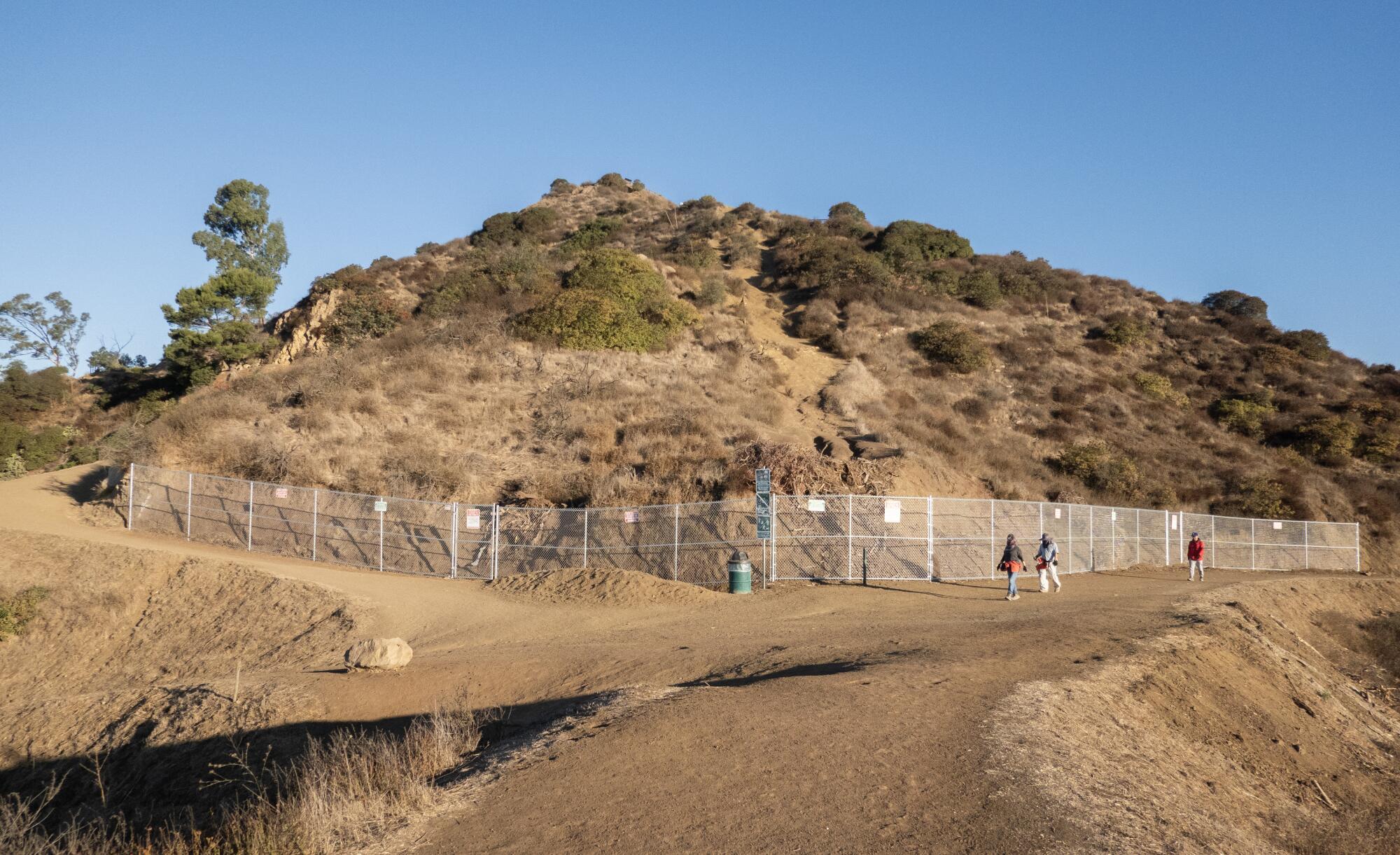-
L.A. wants to ban using nitrous oxide to get high. But challenges loom - 8 mins ago
-
Atmospheric River Set to ‘Wallop’ Western US: What We Know - 23 mins ago
-
Europe Begins to Ask if Syrians Can Go Home After al-Assad’s Fall - 33 mins ago
-
Los Angeles County plans to raze historic headquarters building - 48 mins ago
-
Cat Helping Owner Bake Chocolate Cake Delights Internet: ‘Sous Chef’ - 57 mins ago
-
UnitedHealth Group C.E.O.: Brian Thompson Was Never Content With the Status Quo - about 1 hour ago
-
Mystery ‘Orbs’ Appear To Hover Over Minnesota Sky - 2 hours ago
-
The Stock Market and TV: Trump’s Most Durable Guardrails - 2 hours ago
-
I Found Dad’s Last List 20 Years After He Died. It Made Me Cry - 2 hours ago
-
Donald Trump’s Favorability Rating Is Positive for First Time Ever - 3 hours ago
No one is on the fence about the ‘obscenity’ in Griffith Park: chain-link trail barriers
• Griffith Park is an urban wilderness sanctuary, and hikers love its popular, twisty trails.
• But two new fences that block short-cuts have led to heated meetings and a petition demanding their removal.
• They were intended as a safety measure and to protect habitat, but one of the regulars labeled the fences an “obscenity.”
Pete Teti, who was about to turn 101, left me a phone message a few weeks ago, and I could tell by his tone that he was ticked off about something.
When I reached him, he invited me to come out one morning and hike his favorite trail in Griffith Park. He wanted to show me where the city had installed two monstrous fences, ostensibly to protect habitat and keep hikers from veering off the main trail. But Teti didn’t appreciate having his urban wilderness sanctuary turned into what looked like a construction site.
Teti, like many regulars, does not have a casual relationship with Griffith Park. He loves it, and he loves that others do as well. A morning walk with him is both a celebration of Los Angeles and a trip around the world — he’s like a park ambassador, greeting locals and tourists of all ages and ethnicities.
California is about to be hit by an aging population wave, and Steve Lopez is riding it. His column focuses on the blessings and burdens of advancing age — and how some folks are challenging the stigma associated with older adults.
Just before Thanksgiving, I met up with Teti and two of his pals, a retiree named Tom McGovern and an artist named Ramsess, a former L.A. Times illustrator. We started at the Charlie Turner Trailhead near Griffith Observatory and followed the Mt. Hollywood Trail a few hundred yards before coming upon the first of two fences.
The barrier, about 8 feet high and maybe 100 feet in length, blocked access to what has been used for many years as a shortcut trail to the Mt. Hollywood Summit, which is now designated as the Tom LaBonge Panorama after the late L.A. City Councilman who championed the park.
One sign posted on the fence read: “Trail Closed For Safety And Upcoming Habitat Restoration.”
So here’s my question: If you’re going to put up a fence to keep people away, why would you then leave the gate open so they could march through and up the steep, rocky incline? Another question about the fence: What’s to keep people from walking to the end and stepping around it?

Daily hikers Pete Teti, left, and Tom McGovern are among those who are upset about fences that went up along hiking trails at Griffith Park.
(Myung J. Chun / Los Angeles Times)
The four of us were bewildered. There’s danger everywhere in the city and the park, Tetti said. Is the level of risk any greater in this location? And regarding habitat protection, won’t hikers create new shortcuts that cause damage elsewhere?
After Teti got done chatting with a few dozen triathletes on a morning run, we continued up the trail to the second fence, which blocks access to another shortcut trail. As with the lower fence, the only good thing I can say about it is that it’s not topped by razor wire. It’s 200 feet in length and posted with warnings, including one that says trespassing and loitering are punishable by fines up to $1,000.
I told the crew I’d work on getting an explanation for the fences, and find out what they cost. Meanwhile, as of a few days ago, more than 250 people had signed a petition demanding the removal of the fences. The petition lauded the goal of protecting habitat and reducing risk but questioned the need for fences, calling them ugly and ineffective.
“These fences really are an eyesore!” said one post.
“Yes, hikers get hurt,” said another. “But fences aren’t the answer!”
“You cannot simply close a trail and expect the habitat to restore itself without further intervention,” said another post, which questioned the city’s long-term commitment.
A spokesperson for Los Angeles recreation and parks told me the gate on the lower fence would soon be locked (by Friday morning, it was). I’m still waiting on stats regarding rescues on those trails, but I did get the cost of the two fences.

The two fences along hiking trails in Griffith Park are intended as a safety measure and to protect habitat.
(Myung J. Chun / Los Angeles Times)
The bill came to $45,589.
On Thursday evening, the arguments for and against the fences got fleshed out at a meeting of the Griffith Park Advisory Board.
“No one likes a fence, but fences are temporary,” said Sgt. Sean Kleckner, a park ranger. “And at some point in time the fences will come down. … But that’s probably not going to be for some time.”
Kleckner said that taking safety and habitat into account, the fences were the right call. (Courtney McCammon, a park ecologist, said native vegetation including sagebrush, buckwheat, brickellbush, deergrass and sage scrub will be planted to restore the area.)
There’s wildfire danger on the slopes in question, Kleckner said, adding that for several years, between 12 and 20 stranded or injured hikers have been rescued annually. He said those rescues stress ranger forces and the Los Angeles Fire Department, which sometimes sends helicopters.
One speaker said he’s seen people get injured on the trails and he has helped in rescues. He applauded the installation of the fences, but the majority of speakers were opposed.

The cost of the two fences at Griffith Park? $45,589.
(Myung J. Chun / Los Angeles Times)
Yasmine Ross said she checked with the LAFD and by her accounting, the vast majority of park rescues over the last three years did not occur near the new fences.
Justin Szlasa said signs would have been better than fences, or, alternatively, improving the trails in question to make them safer.
Teti’s buddy, McGovern, called the fences “an obscenity,” and questioned their need. “When you consider the thousands of people that come to the park every year, the number of incidents that have happened is very small.”
Teti, who also raised his hand to speak, informed the board that he’s been hiking in Griffith Park every day for 22 years, and that he just turned 101. When the applause died down, he said that in all that time, he’s seen only one person fall. If people want to try a steeper slope, he said, “they know they need to be careful. Usually they are.”
Teti, who has no trouble hiking a couple of miles on his morning trek across hilly terrain (and sometimes whips out a harmonica and blows a tune for dogs or other hikers), added this: “Some people like a little more of a challenge. Like me. I don’t want that taken away from me.”
Gerry Hans, president of Friends of Griffith Park, attended the meeting, and I later checked with him for his take on the fences.

One of the Griffith Park regulars says, “When you consider the thousands of people that come to the park every year, the number of incidents that have happened is very small.”
(Myung J. Chun / Los Angeles Times)
“I knew something had to be done,” said Hans, who has witnessed rescues, seen habitat destruction and thinks that with 53 miles of primary trails, shortcuts should be discouraged.
But he added that “tall shiny fences” should have been “the last resort.” He would have preferred starting with signage that “promotes peer pressure to do the right thing, to respect the park and urban wilderness and habitat.” He brought such a sign to the meeting, and it said, “NOT A TRAIL! For your safety, and to protect the habitat, please stay on designated trails.”
It was green, by the way.
Not chain-link gray.
steve.lopez@latimes.com
Source link




















